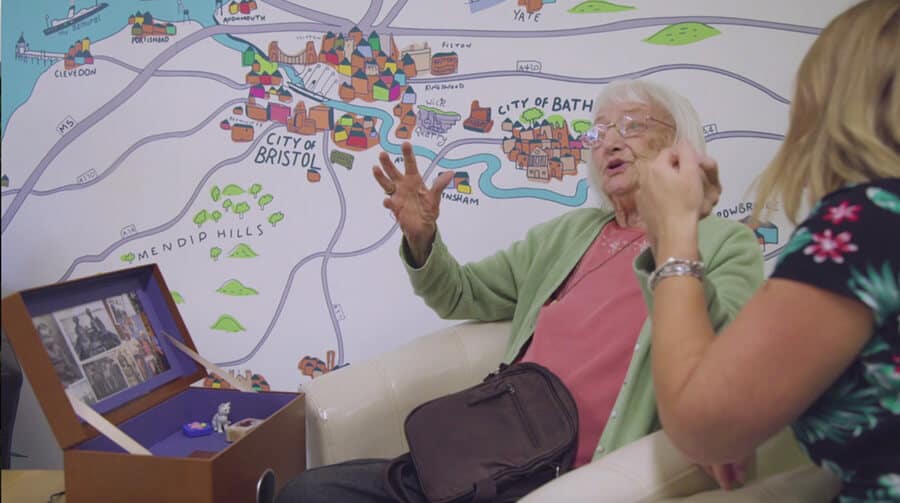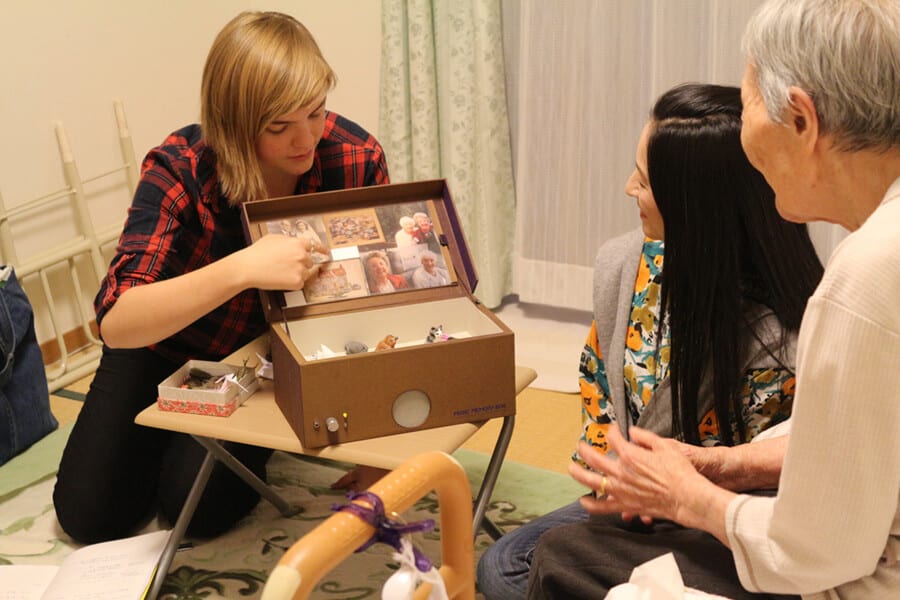If it wasn’t for Great Granny Winnie, hundreds of people with dementia would never had the chance to improve their memory through the powerful link of photos, objects and notes. At the age of 104, she could still play the piano, but she couldn’t remember her granddaughter. This fact inspired designer and innovator Chloe Meineck to create the Music Memory Box – a multi-sensory device that has helped hundreds of families so far to reconnect with their loved ones suffering from memory loss.
Chloe is a curious young girl who studied 3D Design and Craft at Brighton University. She always wanted to know how complicated things worked and enjoyed experimenting with woodwork, fine art and science hacks. Growing up with a Granny with dementia she noticed that after playing the piano, her grandmother would be able to recall a lot of her memories. This inspired her to found Studio Meineck, a creative hub for developing technological products that address mental health issues. Also, this is the exact place where her handmade wooden piece of art has been created. The Music Memory Box project got her the internationally recognised reward – she became one of the winners of Innovators Under 35 Europe from MIT Technology Review. After years of development and hundreds of sessions with people living with dementia all around the UK and Japan, Music Memory Box is a step away from becoming a commercial product that will make a global impact for all of those who need it.
Chloe, what makes you excited and busy these days?
Thinking and working out the impact and change I can have always keeps me excited, and there are lots of issues and challenges right now! So lots of work to do – but I’m conscious of conserving my energy and properly resting after projects.
I’ve just finished a men’s mental health project around suicide prevention here: www.myweatherreport.org. Using the visual metaphor of weather to relate to inner weather and mental health. So I am taking a breather after creating the first version of this, to work out what I can do next in this challenging time.
The first version of your internationally recognized and award-winning project, Music Memory Box was designed in 2010 and since then it has helped hundreds of people with dementia. Still, it all started with your grandma Winnie. How did it change your relationship?
It all started with my Great Gran Winnie. She inspired the creation of Music Memory Box because music was so important to our connection. And used to bring us back together again, she could still play the piano at 104 with later stages of dementia. Music and singing was one of the only comforts we had to connect. I was always interested and really confused how she could play the piano, but not remember who I was. When I started creating the music memory boxes with people living with dementia, it helped me bond with strangers and people I knew much better as we were communicating in a creative physical way rather than speech.
While studying design you researched a lot about the effects of music on people with mental challenges especially dementia. What do you think is the link between their brains and the music they hear or play?
The connection between music, emotion and memory is in the part of the brain, that is the least affected by Alzheimer’s Disease. Meaning music we have an emotional connection to has an amazing effect on all people but especially with people living with dementia. It takes us back to a place, the people we were with and what we were doing. Wedding songs, lullabies, songs that you sing as a child, gigs that you went to as a teenager can all be great memory prompts for people living with dementia.
How it Works
How does the Music Memory Box work and what is the technology behind it?
The Music Memory Box is a physical box that is filled with personal objects using RFID technology (similar to NFC) used within phones to pay for goods at shops nowadays. Each object can set off an individual piece of music. Meaning people living with dementia can access their favorite important music through moving meaningful objects. The music and tactile object triggers memories and reminiscing for the person living with dementia.

Apart from being helpful with a memory and certain behavior patterns what other positive psychological effects does the Music Memory Box have on people with dementia?
A way to communicate to family members and to connect them together. Improves the person’s sense of connection to both themselves and their identity and to other people. By being better connected to yourself and your memories and identity it can reduce confusion and agitation. Better sense of independence as they can use it on their own. The main part is bringing people together through stories, memories and music.
Thanks to your invention, one daughter heard her dad sing for the first time and life-long partners have been reminded of their love for each other. Have you witnessed or heard about more of emotional situations like this when it comes to families interacting with the box?
One man who had lost the ability to speak through living with dementia and a stroke could no longer to tell his wife he loved her. So he now uses the Music Memory Box to set off their love song that reminds them of where they used to live in Ghana. And then reaches out to hold her hand. For most families it has been something positive to do, to reconnect with each other at a challenging time.
Kick-starting the Music Memory Box
Last year you started a Kickstarter campaign that would help with a massive production of Music Memory Boxes. Can you update us on this?
Due to COVID-19, my micro team, and lockdown restrictions in the UK where it is being manufactured, there have been lots of delays. However we have nearly finished development of the product for manufacturing. A run of 200 will be out in the new year I hope.

As a female innovator you are not only a designer but an entrepreneur and negotiator as well. What is the most challenging part of the business aspect of your job?
Keeping resilient, when literally everything that can go wrong with manufacturing has gone wrong! And spending many years with no funding to develop the tool I had to work out how I could develop it, with little money or resources. The most challenging part is having to prove yourself all the time, it’s like a series of hoops you have to jump through and there are many more if you are a woman and young.
What is next for the Music Memory Box?
The Music Memory Box has just been part of a living lab in Belgium as part of a European funded project. So I guess what’s next is that Music Memory Boxes will start being used across the world to all the families that need it. Which is very exciting.
Unlike traditional memory boxes, the Music Memory Box is multi-sensory device that uses low-cost technology to link photos, objects and music together. The Music Memory Box is also customisable. It can be changed to accommodate personal tastes in music, spanning the different ages of a person’s identity. The more personal the box, the more effective the reminiscing the process is.
Find out more at: www.studiomeineck.com
Photos: From the Archive of Chloe Meineck
Read about another mission to make the world a better place here:
International Day for Tolerance: Building Peace in Kyrgyzstan
Support us!
All your donations will be used to pay the magazine’s journalists and to support the ongoing costs of maintaining the site.
Share this post
Interested in co-operating with us?
We are open to co-operation from writers and businesses alike. You can reach us on our email at cooperations@youthtimemag.com/magazine@youthtimemag.com and we will get back to you as quick as we can.










